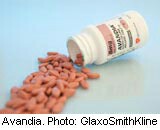New Worries Over Blockbuster Meds Avandia, Fosamax
Diabetes drug Avandia linked to fractures, while bone drug Fosamax is tied to irregular heartbeat.
By Amanda Gardner
HealthDay Reporter
|
E-mail this article
Subscribe to news
Printer friendly version
|

(SOURCES: Spyros G.E. Mezitis, M.D., Ph.D., endocrinology consultant and clinical investigator at Lenox Hill Hospital, and clinical assistant professor of medicine, NewYork-Presbyterian Hospital/Cornell Medical Center, New York City; Nancy Pekarek, spokeswoman, GlaxoSmithKline; Ronald Rogers, spokesman, Merck & Co. Inc.; April 28, 2008, Archives of Internal Medicine;
March 11, 2008, British Medical Journal)
MONDAY, April 28 (HealthDay News) -- Avandia and Fosamax, widely prescribed drugs used to treat two common health conditions, show further evidence of being linked to adverse events.
One study finds that long-term use of thiazolidinediones -- a family of diabetes drugs that includes blockbuster Avandia -- appears to be linked with an increased risk for bone fractures.
And a second study found that Fosamax, used to prevent fractures in women with osteoporosis, may be associated with a higher risk of atrial fibrillation, a type of abnormal heart rhythm.
Both studies were published in the April 28 issue of the Archives of Internal Medicine.
Avandia (rosiglitazone) and Actos (pioglitazone), both thiazolidinediones, now account for 21 percent of all oral anti-diabetic drugs prescribed in the United States. An estimated 3.5 million or more U.S. patients take Avandia, experts say.
But in 2007, Avandia and four other drugs from the same class were given a "black box" warning, cautioning users of an increased of heart problems.
The current study, led by Dr. Christian Meier of University Hospital Basel, Switzerland, looked at links between thiazolidinediones and fracture. It was designed to ascertain whether only women were affected and where fractures were most likely to occur. The research involved 1,020 men and women aged 30 to 89 who had sustained a fracture while taking Avandia, Actos, insulin or another anti-diabetic drug.
Compared to controls, individuals taking Avandia or Actos had more than double the risk of fractures, with the risk with Actos being slightly higher than with Avandia. Drug-associated fractures were particularly common at the wrist and hip. Both men and women were at risk, and the odds for fracture tended to rise with dose of drug taken.
The odds of sustaining a fracture were heightened in patients taking Avandia or Actos for 12 to 18 months and highest in those who were on the medication for two or more years.
Other anti-diabetic drugs did not show the same effect, but thiazolidinediones have a different mechanism of action (working at the cellular level) than other drugs for type 2 diabetes.
The findings echo some previous research which found an increased risk of fractures in women.
For now, the decision to use these particular diabetes drugs should be made on a case-by-case basis, experts said. Women who are postmenopausal and therefore at risk for fractures may want to be more careful, or take other measures to protect their bone health, they said.
"I think the benefit is more than the risk at this point. The benefit is huge in terms of glycemic control," said Dr. Spyros G.E. Mezitis, endocrinology consultant and clinical investigator at Lenox Hill Hospital in New York City.
"It remains to be seen if the way we practice medicine is going to change. These are important analyses, but we need further evidence," Mezitis added.
Nancy Pekarek, a spokeswoman for Avandia manufacturer GlaxoSmithKline, noted, "We do have fractures on our label and, in fact, when we saw data from the ADOPT (a previous, long-term trial), we issued a 'dear doctor' letter."
"The fractures have been observed, and we have made physicians aware of that so they can be watching for their patients and choose which drug is appropriate," Pekarek said. Unlike this trial, the fractures seen in ADOPT were more likely to be in the upper arm, hand or foot as opposed to hip and spine.
The Fosamax study, led by Dr. Susan Heckbert of the University of Washington and Group Health, Seattle, looked at 719 women with confirmed atrial fibrillation in a "real world" setting, versus 966 controls (without atrial fibrillation).
The study found that 6.5 percent of women who had used Fosamax had atrial fibrillation compared to 4.1 percent of controls. Based on these findings, the researchers estimated that 3 percent of new cases of atrial fibrillation in this group of women might be attributable to the use of Fosamax.
Again, the authors cautioned, risks and benefits should be carefully weighed when prescribing the drug.
Other studies have also reported atrial fibrillation as a side effect of bisphosphonates, the class of drugs that includes Fosamax.
Ronald Rogers, a spokesman for Fosamax manufacturer Merck & Co. Inc., called the Fosamax-fibrillation association an "old issue." He also pointed to an article published earlier this year in the British Medical Journal that found no such association.
Rogers also pointed out that the current study is an observational one and therefore subject to limitations not seen in a previous randomized trial. That trial saw an increase in the incidence of "serious" atrial fibrillation among Fosamax patients, he said, but it did not reach a statistically significant difference.
More information
There's more on type 2 diabetes at the American Diabetes Association. 
Copyright © 2008 ScoutNews, LLC. All rights reserved. 
HealthDayNews articles are derived from various sources and do not reflect federal policy. healthfinder.gov does not endorse opinions, products, or services that may appear in news stories. For more information on health topics in the news, visit the healthfinder.gov health library.